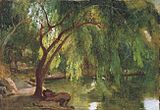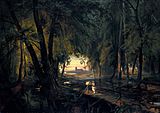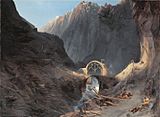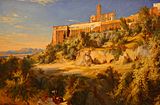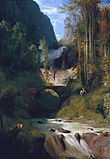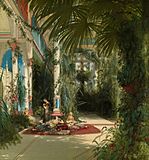Carl Blechen facts for kids
Quick facts for kids
Carl Blechen
|
|
|---|---|
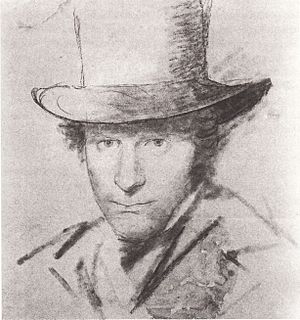
Self-portrait (1825)
|
|
| Born |
Carl Eduard Ferdinand Blechen
29 July 1798 |
| Died | 23 July 1840 (aged 41) |
| Nationality | German |
| Occupation | painter, professor |
Carl Eduard Ferdinand Blechen (born July 29, 1798 – died July 23, 1840) was a German landscape painter. He also worked as a professor at the Academy of Arts, Berlin. His unique painting style showed the ideas of Romanticism, which focused on natural beauty.
About Carl Blechen's Life

Carl Blechen was born in Cottbus. His father was a tax official, and his mother was from the Sorbs people. From 1805 to 1815, Carl went to school in Cottbus. His parents could not pay for him to study more. So, he became a banker's helper until 1822.
But Carl became more and more interested in art. In 1822, he decided to go to the Berlin Academy to study art. After a short trip to Dresden and Saxon Switzerland, he came back to Berlin. He got a job as a decorator for the Royal Theater.
In 1824, Carl got married. In 1827, he joined the Berlin Artists' Association. Later that year, he lost his job at the theater. This happened because of a disagreement with a singer named Henriette Sontag. After that, he tried to make a living as a free artist.
In 1828, he traveled to the Baltic Sea to study. Then he went on a trip to Italy. He made hundreds of sketches there. Later, he used these sketches in his studio in Berlin. The landscapes in Italy really impressed him. He changed his whole way of painting because of what he saw.
Later Years and Health Struggles
In 1831, Carl Blechen became a Professor of Landscape Painting at the Berlin Academy. This happened because Karl Friedrich Schinkel suggested him for the job. Even with this new job, King Frederick William III asked Blechen to paint an indoor scene. This painting was called The Interior of the Palm House on the Pfaueninsel Near Potsdam.
In 1835, Carl became a full member of the Academy. He also took a study trip to Paris. Around this time, he started to have health problems. His condition got worse, and he had periods of feeling very sad and unwell. Because of this, he had to take time off from the Academy in 1836.
The next year, he had to go to a hospital. He was able to make one last trip to Dresden. There, he made his final drawings. Carl Blechen died four years later in Berlin. He was very ill at the time. He was buried in the Holy Trinity Cemetery (II). We do not know the exact spot where he was buried today. A special plaque on the cemetery wall remembers him.
A street, a park, and an elementary school in Cottbus are named after him. In 2008, the school building became part of a big shopping center called "Blechen Carré". Most of his paintings are owned by private collectors. Carl Blechen was one of the first European painters to show early factories and machines in his landscapes.
Gallery
See also
 In Spanish: Carl Blechen para niños
In Spanish: Carl Blechen para niños


